While in Winnipeg last month,
Jeem and his lawyer friend,
B.T. Mandelbaum,
discovered that this is a friendly city. Truly friendly. Everyone seemed friendly. Winnipeg is not Vancouver.

They also discovered an exciting reflection of the multicultural diversity of Canada, of the First Nations, and our country's two official languages. And they found it on every street corner and in every coffee shop in Winnipeg. Again, this is not Vancouver.
However. They also were confounded by a couple of things.
First: what's with the poles attached to most of the fire hydrants in the city, especially in the residential districts? Surely to god the fire fighters can see the hydrants easily enough muttered Jeem. Why the poles then, offered B.T. Maybe a flag pole for Canada Day? suggested Jeem. That's just dumb replied his older, wiser lawyer friend.


The second question: what are these strange metal box contraptions attached to most stop-light poles at nearly every intersection in Winnipeg? At first B.T. thought they might dispense some sort of ticket for transit. Like a Pez dispenser added Jeem. The duo actually started to stick their fingers in these things until they noticed Winnipegers laughing at them.

In the end, B.T. came up with a logical answer to the first question, one that most Canadians would have recognized much earlier than the two from the Left Coast.

The fact is, said Mandelbaum, Winnipeg gets a lot of snow, and when the streets are plowed the snow piles up. It doesn't disappear later the same day as in Vancouver. The poles show fire fighters where the hydrants are buried under all that snow. Ahhhh, thought Jeem, in admiration for his legal adviser, though in truth B.T. Mandelbaum had been disbarred years ago.

It took the help of an actor in
Sherry MacDonald's play, The Seduction Theory, to answer the second question, without laughing at the ridiculousness of these two goofs from Lotus Land. Apparently, and Jeem checked it out for himself, given the weather of Winnipeg, these metal attachments contain the electronic speakers which aid the blind and visually impaired while crossing the street with the beeping noises we hear across Canada, and even in Vancouver. Hmm, thought Jeem. I see. And we were sticking our fingers in there, said B.T.

Questions. Answers. Sometimes they are both much simpler than they appear. But what in the world is a statue of the British actor, Ben Kingsley (born as
Krishna Bhanji) , doing outside the Canadian Museum for Human Misery? Jeem and B.T. Mandelbaum never did find out.
Photos by Jeem. Copyright 2016 by Jim Murray.
























